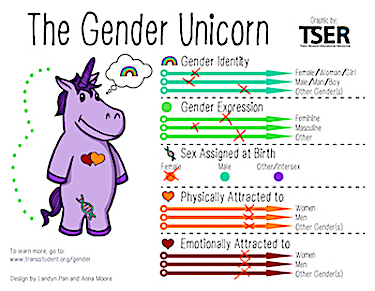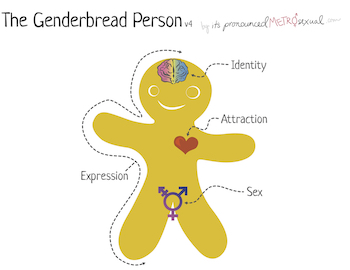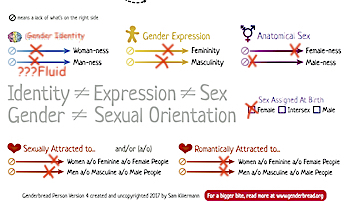Growth
Gender vs. Sex vs. Orientation: An Introduction to These Elements of Identity
It goes without saying that people are complex beings. Each person contains a unique blend of traits, preferences, and quirks that makes them who they are. What can be difficult to understand, though, are the traits including gender, gender expression, and sexuality and how they are (or are not) connected to each other.
While things are improving, Western society has traditionally conflated these facets of identity in a way that has left little room for any person outisde the prescribed "norm" to express themselves freely and safely.
The conventional identity "formula" is this:
- anatomical sex = gender identity/expression = attraction to the "opposite"
- male = masculine = man = attracted to women
- female = feminine = woman = attracted to men
The male/female categories described above constitute what is known as the gender binary, and after some thought, you'll notice it has many problems with how it measures-up to reality.
If we truly respect people for who they are (including ourselves), and who they know themselves to be, we have to ask ourselves some questions:
- What are the boundaries to these categories?
- At what point in the binary system does a person flip from fitting into one box instead of the other?
- Does each person fit neatly into one of these categories?
More accurately, the supposed binary breaks down into these categories:
- Anatomical (Biological) Sex / Sex Assigned at Birth
- Gender Identity
- Gender Expression
- Romantic Attraction
- Sexual Orientation
The rest of this article is dedicated to describing each one of these traits, and I conclude with a tool to help you locate where you identify for each one.
Anatomical (Biological) Sex
What is anatomical (biological) sex (more recently termed Sex Assigned at Birth)?
Anatomical sex is what a person is born with in a physical sense: genitals, chromosomes, hormonal patterns, and physical features such as body hair, body shape, etc.
It is true that most people are born with physical traits that are clearly female or male, but the binary assumes that all people fit into the anatomical categories of male or female. In reality, however, a significant percentage (up to 1.7%) of people are born intersex.
Intersex is a genetic phenomemon in which people are born with features that do not align perfectly with the biological sexes of male or female. Sometimes these characteristics are visible on the external body, and sometimes the features are internal. This umbrella category for those that don't fit into the male/female binary is effectively a "third" anatomical sex.
So, if you're looking at biology, alone, the binary doesn't hold up. We'll see later that the binary doesn't hold up in a psychological sense, either.
There are many genetic profiles that could place a person into the intersex category of anatomical sex. You can read more about it here.
Note that some transgender people decide to undergo gender confirmation surgery or hormone therapy through which they transform their bodies to match their gender identities.
Gender Identity
Gender identity is how an individual knows themselves (in a psychological sense in terms of "woman-ness" or "man-ness"). According to genderbread.org, "Gender identity is all about how you think about yourself. It’s about how you internally interpret the chemistry that composes you." TransStudent.org puts it this way, gender identity is "One’s internal sense of being male, female, neither of these, both, or other gender(s)."Again, for most people, the assigned gender at birth aligns with the anatomical sex, and there is no internal dissonance or question about gender identity. This is the cisgender identity.
In other cases, though, a person may have a feeling of inner conflict in which their assigned gender doesn't align with their anatomical sex. Some of these people may identify as transgender, nonbinary, agender, or another gender type. You can find a non-comprehensive list of gender identities here.
One's gender identity may be fluid and evolve throughout the course of their life. This doesn't mean that person is confused or engaging in attention-seeking behavior. People change in lots of ways as they grow and mature, and gender identity is just one way that someone's sense of themselves could change.
Gender Expression
Gender expression is how a person shows gender. This is expressed in the way someone dresses, behaves, and how they interact with others. This is where we usually apply terms like "masculine" and "feminine" to how a person may demonstrate gender in social systems.
People typically express themselves in accordance to their gender identity (e.g. someone who identifies as a man, acts "masculine", and wears men's clothing), but there are cases in which people express a gender that does not align with their gender identity. This is especially true for those who feel they may be in danger if they express themselves authentically in a culture that does not accept and respect gender non-conforming people.
The murder of transgender and gender non-conforming people is tragically common, especially for trans People of Color. The Human Rights Campaign tracks fatal violence against trans people, and you can find reports and other informative resources related to transgender issues here.
Romantic Attraction and Sexual Orientation
A person's anatomical sex, gender identity, and gender expression all function independently of who they may feel attracted to. The types of people one may be attracted to determines sexual orientation (e.g. bisexual, homosexual, heterosexual, etc.), and there are two dimensions to attraction: romantic attraction and sexual attraction.
Romantic attraction, according to genderbread.org, is "an affinity and love for others and the desire for emotional relationships."
Sexual attraction is "the want, need, or desire for physical sexual contact and relationships."
Some people feel both kinds of attraction equally when they encounter someone they're attracted to, and others might feel only one or the other. For example, an asexual person feels no sexual attraction to others but can feel romantic, and an aromantic person feels no romantic attraction toward others but might feel sexual attraction.
How to process this information...
Thinking about anatomical sex, gender, and types of attraction can be overwhelming and confusing if you've never considered that they all function independently to create our unique identities.
This is where the Gender Unicorn or the Genderbread Person can help!
The Gender Unicorn and Genderbread Person are a visual tools used to better understand the various spectrums upon which we perceive ourselves.
Each trait I've described exists on a spectrum, and every person will place themselves in a unique place on each one. You can find a high-resolution images of the Gender Unicorn here and the Genderbread Person here.
The Gender Unicorn is the more flexible iteration of the two tools, and sets itself apart from the Genderbread Person in a few ways. According to transstudent.org:
"You may recognize this graphic as similar to The Genderbread Person by itspronouncedmetrosexual. We created this graphic with significant changes to more accurately portray the distinction between gender, sex assigned at birth, and sexuality. Ultimately, we wanted to recognize genders outside of the western gender binary, which the Genderbread Person does not. Not all trans people exist on a scale of womanhood and manhood. There are several other issues with this graphic such as the use of the inaccurate term “biological sex,” the use of “asex” (which fails to recognize that everyone has sex characteristics prescribed to them), and several other issues with terminology and presentation."
Examples: My Profiles
Below, you'll find my Gender Unicorn and Genderbread Profiles. I've filled them in to help you understand how it works.
My sex assigned at birth is female, and I am a nonbinary, gender-fluid/genderqueer, pansexual person.
Nonbinary is an umbrella gender identity meaning I perceive myself outside the gender binary of strictly woman or man. Gender-fluid/Genderqueer means my sense of gender is flexible. Sometimes I feel more feminine, sometimes I feel more masculine, and sometimes I feel non-specific. The pansexual orientation means I can potentially be attracted to any person of any sex or gender.
You can see where I fit on each spectrum on the image below. For each category, the left end of the spectrum represents an absence of that thing, and the right end of the spectrum indicates the highest level that thing could be.



Final Thoughts:
What's your Gender Unicorn or Genderbread Person Profile? Enjoy thinking about it, and get to know yourself a little better! Embrace who you are on the sex, gender, and orientation spectrums! The binary has always been imaginary, anyway! This article is simply meant to be an introduction, and there are many great resources online about gender and sexual orientation if you want to learn more.
by KaDee Bramlett
published 02/20/2021
edited on 02/22/2021 to add more inclusive resources and clarify some information
This is an ad-free space. If you'd like to contribute to help me continue creating this content, I accept contributions on Venmo @KaDee-Bramlett. Thank you!